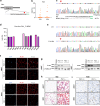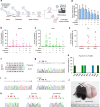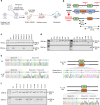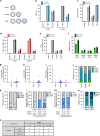An innovative approach using CRISPR-ribonucleoprotein packaged in virus-like particles to generate genetically engineered mouse models
- PMID: 40216739
- PMCID: PMC11992299
- DOI: 10.1038/s41467-025-58364-7
An innovative approach using CRISPR-ribonucleoprotein packaged in virus-like particles to generate genetically engineered mouse models
Abstract
Genetically engineered mouse models (GEMMs) are crucial for investigating disease mechanisms, developing therapeutic strategies, and advancing fundamental biological research. While CRISPR gene editing has greatly facilitated the creation of these models, existing techniques still present technical challenges and efficiency limitations. Here, we establish a CRISPR-VLP-induced targeted mutagenesis (CRISPR-VIM) strategy, enabling precise genome editing by co-culturing zygotes with virus-like particle (VLP)-delivered gene editing ribonucleoproteins (RNPs) without requiring physical manipulation or causing cellular damage. We generate Plin1- and Tyr-knockout mice through VLP-based SpCas9 or adenine base editor (ABE)/sgRNA RNPs and characterize their phenotype and germline transmission. Additionally, we demonstrate cytosine base editor (CBE)/sgRNA-based C-to-T substitution or SpCas9/sgRNA-based knock-in using VLPs. This method further simplifies and accelerates GEMM generation without specialized techniques or equipment. Consequently, the CRISPR-VIM method can facilitate mouse modeling and be applied in various research fields.
© 2025. The Author(s).
Conflict of interest statement
Competing interests: T.Y.J., D.E.Y., J.K.S., and K.K. have filed a patent application with the Korea Patent Office (Application No. 10-2024-0046182) related to the generation of genetically engineered animals using the CRISPR-VLP system and its applications described in this study. The other authors have no competing interests to declare.
Figures






References
MeSH terms
Substances
Grants and funding
- RS-2023-00261905/National Research Foundation of Korea (NRF)
- RS-2023-00220894/National Research Foundation of Korea (NRF)
- RS-2023-NR077033/National Research Foundation of Korea (NRF)
- RS-2024-00441068/National Research Foundation of Korea (NRF)
- NRF-2014M3A9D5A01074636/National Research Foundation of Korea (NRF)
LinkOut - more resources
Full Text Sources
Miscellaneous

